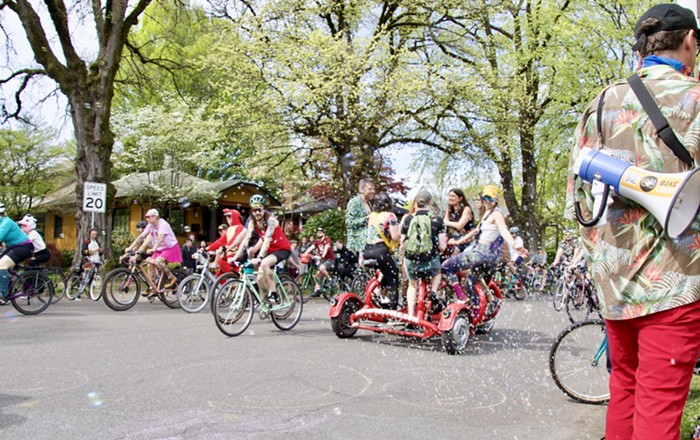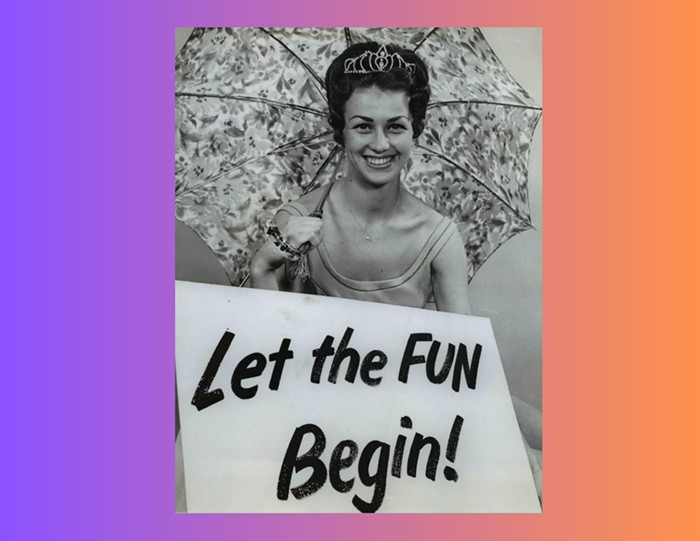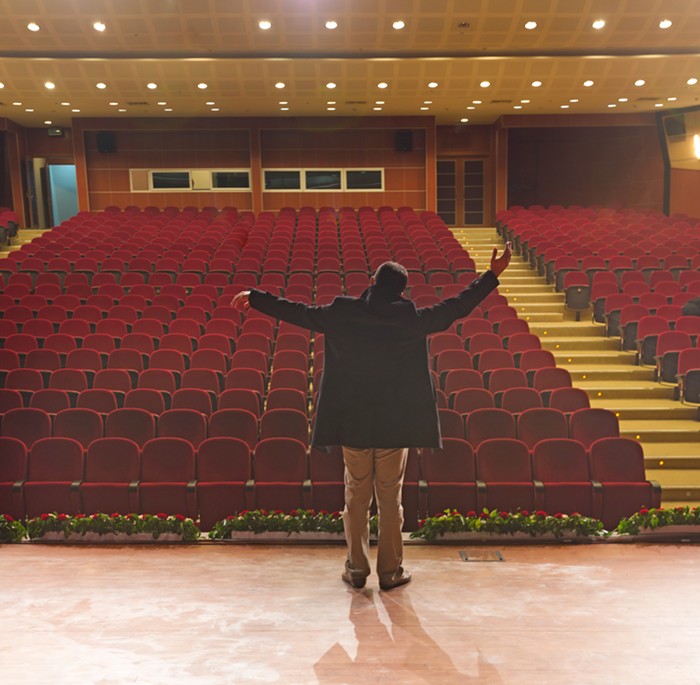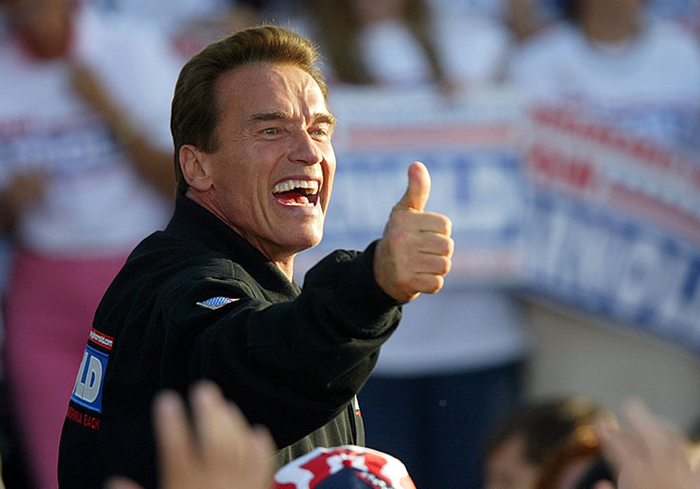IMAGINE THE BOLD future of Portland: In a year, 750 tourist-friendly rentable bikes will be locked to 75 high-tech stations all over the central city.
That's the plan anyway—the one city council signed off on last December. But local operator Alta Bicycle Share still needs to secure a corporate sponsor to cover at least $2.9 million in start-up costs, and the details of where the city will locate stations or what the system will do about helmets are unknown. Wouldn't it be nice if we could briefly swap a bike for a DeLorean, zip into the future, and figure out what problems Portland's bike share will face? Luckily, other American cities are years ahead of Portland: Minneapolis, Boston, Washington, DC, and (most recently) New York have already rolled out rentable fleets of their own.
We asked four writers to give us a glimpse of Portland's future from those four cities—they're our only hope to alter the future... from the past!
___________________________________________________________
TWIN CITIES
Minneapolis is Portland's arch-frenemy in all things biking—they have a lot of bike commuters, their off-street paths are way better, and one time Bicycling magazine said they were the #1 biking city in the country because they pedal through the snow, too.
Here's what Portland can learn from the Twin Cities, which placed bright green bikes around the city in 2010:
Bike share is cooler if it has a meaningful brand name—and a big money sponsor. Let's be honest: If Phil Knight took a few bong hits on a Saturday afternoon, called up Mayor Charlie Hales and announced that Nike would sponsor Portland's bike share as long as everyone referred to it only as "The Swooshnet," Hales would cheer. So it says something that Minneapolis, a city where you can't swing a u-lock without hitting a Fortune 500 executive, settled on branding its bike-share system not with the name of its top sponsor, Blue Cross and Blue Shield of Minnesota, but simply "Nice Ride." This is a name that not only co-opts the beloved cultural attitude that is "Minnesota Nice," but that is also basically impossible to say without assuming a slight Minnesota accent.
Keep low, low prices. At $65 a year or $6 a day, the right to use Nice Ride bikes whenever you want is much cheaper than the $100 a year, $10 a day memberships you'll see in big cities. "They can price whatever they want in London and they'll still have people lining up to use it," says Nice Ride Executive Director Bill Dossett. Not so in MSP, and not in PDX.
Don't just serve the rich parts of the city. When Nice Ride launched with 65 stations in 2010, folks in North Minneapolis said it wasn't fair that as a historically underprivileged community subject to systemic oppression for decades (totally true), they didn't get any bike-share stations. Fortunately, Nice Ride ridership is up 172 percent since year one, and the system has added stations on the north side. The whole point of publicly funding bike share is to make sure it's accessible to everyone. Gotta keep that in mind, doncha know?
—Michael Andersen, news editor for bikeportland.org and lead writer for greenlaneproject.org.
_________________________________________________________________________________________
NEW YORK
Before New York's bike-share system—called Citi Bike—launched with 6,000 bikes this May, New Yorkers behaved as if bike sharing was a total mystery. Confusion about the pricing, biking, and locking abounded. Maybe Portland can save itself some angst by following these lessons from our metropolis:
Launch bike share fast as you can. There's no better way to understand how bike sharing works than to see it in action. The faster you can get your system running the less time there will be for confusion and speculation to metastasize.
Don't put bike share on a pedestal. Like all systems, bike share won't be without a few hiccups, such as empty stations or mechanical problems. Don't hold bike share to a higher standard than you hold other things in Portland, like TriMet or the Trail Blazers.
Bike sharing needs to exist apart from your established bike culture. From cargo bikes to the World Naked Bike Ride, Portland's bike culture is legendary, but it won't register with the typical bike-share user. Nor should it. New York has a lot of everyday bike commuters, but the success of our system and yours will be measured by the number of regular Joes who use it to get from A to B.
—Doug Gordon, editor of brooklynspoke.com
_________________________________________________________________________________________
BOSTON
Boston is three years ahead of Portland on bike share—our system (called the "Hubway" after that long-ridiculed notion that Boston is the hub of the universe) rolled out 600 bikes in 2011 and now has 1,100 bikes at 112 stations. By any measure that is success, and there have been few detractors from the start. Here's what we've learned:
Build stations close together and add bikes—fast! Hubway began with a focus on downtown, where residents in tiny apartments often don't have room to store their own bikes. From the start, bike stations were placed quite close to each other so that users felt they were never too far from a bike and that cycling seemed easier than hiking. Plus, stations were usually built on wide sidewalks so as not to take up valuable parking.
Someone smart: Make a bike-share app now. One frustration for Hubway's riders has been caused by its success: A docking station might be empty of bikes just when you are running late, or a rack is full when you reach your destination. A smartphone app that tells you how many bikes are at each rack is an essential companion.
And a helmet-rental system, while you're at it. Boston still doesn't feel like a particularly safe city in which to cycle. Nine cyclists have been killed on the streets of Boston in the past three years, though none of them riding in the bike-share program. It's all too easy to head out the door without your helmet and only realize later that you want to use a Hubway bike. One local startup is working on bike helmet-rental kiosks to be placed next to bike-rental stations. Sign me up for that, too.
—Jonathan Dyer, writer and Bostonian
_________________________________________________________________________________________
WASHINGTON, DC
DC first tiptoed into bike sharing in 2008, with 10 stations sporting 120 bicycles. Now we're home to the country's second-largest system, after New York.
Go big or go home. DC needed a robust bike-share network to give riders a reliable shot at finding a rental station where they needed to go. DC's second attempt at bike share, called Capital Bikeshare, has been enormously popular, growing into a regional program with more than 1,800 bright red bicycles stationed at 200 docks. By the end of 2013, the total fleet is expected to reach 3,700 bikes at more than 300 stations.
People will bike if it's quick and easy. Surveys show that the most-compelling reason for choosing bike share over other modes of transport is that it's the quickest or easiest way to get around. More than half of our bike-share users have reduced their driving or taxi trips, helping members to save an average $800 over the year. Many use the bikes to connect with the metro or a bus.
Bike share can be financially stable. Unlike some other bike-sharing programs, Capital Bikeshare didn't start out with a major corporate sponsor, nor did it set out to be a big money maker. However, to the surprise of many, the DC portion of Capital Bikeshare is now basically covering its operating expenses. Tourists get a short-term membership to ride around downtown, but locals use the system's high density of downtown bikes, too, to travel between meetings or make impromptu lunch trips. With 4 million trips and counting, bike sharing has become a part of the DC-area landscape.
—Janet Larsen, director of research at Earth Policy Institute (earth-policy.org)














